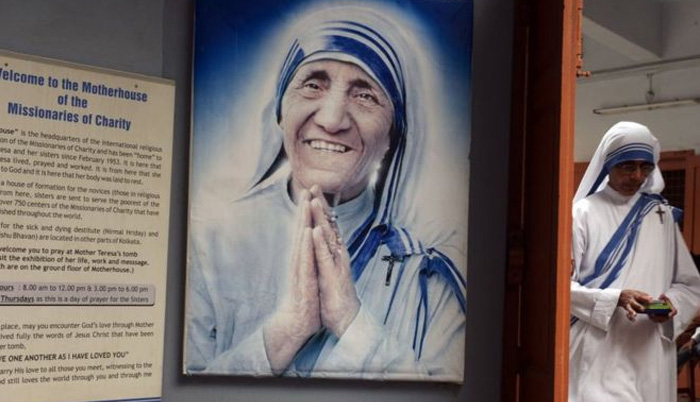![]() Home > Asia
Home > Asia
Why Was Mother Teresa's Uniform Trademarked?

Mother Teresa wore a simple white sari with three blue stripes on the border
![]() July 13th, 2017 | 08:29 AM |
July 13th, 2017 | 08:29 AM | ![]() 3022 views
3022 views
KOLKATA, INDIA
For nearly half a century, Mother Teresa, the Roman Catholic nun who worked with the poor in the Indian city of Kolkata (Calcutta) wore a simple white sari with three blue stripes on the borders, one thicker than the rest. Senior nuns who work for Missionaries of Charity, a 67-year-old sisterhood which has more than 3,000 nuns worldwide, continue to wear what has now become the religious uniform of this global order.
On Monday, news washed up that this "famous" sari of the Nobel laureate nun, who died in 1997, has been trademarked to prevent "unfair" use by people for commercial purposes. India's government quietly recognised the sari as the intellectual property of the Missionaries of Charity in September last year, when the nun was declared a saint by the Vatican, but the order had decided not to make it public.
Biswajit Sarkar, a Kolkata-based lawyer who works pro-bono for the order, says he had applied for the trademark in 2013. "It just came to my mind that the colour-identified blue border of the sari had to be protected to prevent any future misuse for commercial purposes," he told me. "If you want to wear or use the colour pattern in any form, you can write to us and if we are convinced that there is no commercial motive, we will allow it."
The austere blue-trimmed white sari has long been identified with the nun and her order. The story goes that in 1948, the Albanian nun, with permission from Rome, began wearing it and a small cross across her shoulder. According to some accounts, the nun chose the blue border as it was associated with purity. For more than three decades, the saris have been woven by leprosy patients living in a home run by the order on the outskirts of Kolkata.
Nuns say Mother Teresa had issued orders before her death that her name "should not be exploited for commercial purposes".
Accordingly, Mr Sarkar helped the order to trademark her name two decades back. Still, nuns of the order have complained that Mother Teresa's name was being exploited for commercial gain: a school being run in her name in Nepal where teachers complained of not receiving salaries; a priest raising funds in Romania using the order's name; shops near the order's headquarters in Kolkata telling customers that proceeds from memorabilia sales were donated to the order; and a cooperative bank in India curiously named after the nun.
"So we decided to do something about it," says Mr Sarkar. "Through this we are trying to tell the world that her name and reputation should not be misused."
Owning a trademark on a colour can be a tricky business. In 2013 Nestle won a court battle against confectionery rival Cadbury, over the latter's attempt to trademark the purple colour - known as Pantone 2865c - of its Dairy Milk bars.
It is also not clear how this trademark on the famous blue striped sari will be enforced. Many online shopping sites already sell variations of "unisex Mother Teresa dress" - blue bordered sari, and a long sleeved blouse.
Also, the move is bound to raise the hackles of the nun's critics - and she has her fair share of them - who have accused her of glorifying poverty, hobnobbing with dictators, running shambolic care facilities and proselytising. "How can anybody appropriate a sari, which has been a traditional Indian dress," one of them asked me, preferring to remain unnamed.
Designers like Anand Bhushan differ. "Some designs of the traditional Indian towel called gamcha, for example, have been trademarked. There's nothing wrong in trademarking a distinctive and iconic design or pattern like Mother Teresa's sari. It's not like anybody is beginning to own the sari.
Source:
courtesy of BBC NEWS
by Soutik Biswas
If you have any stories or news that you would like to share with the global online community, please feel free to share it with us by contacting us directly at [email protected]